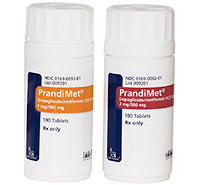Product
PrandiMet
Approval Date
June 23, 2008
Release Date
Second half of 2008
Company
NovoNordisk
Class
Insulin secretagogue, biguanide
Indication
For use as an adjunct to diet and exercise to improve glycemic control in patients with type 2 diabetes mellitus who are already being treated with a meglitinide and metformin or who have not achieved adequate glycemic control with either component alone.
Active Ingredient
Repaglinide plus metformin HCl tablets
Agency Roster
Cline Davis & Mann
Marketing Strategy/Execution
NovoNordisk’s PrandiMet will be sold by diabetes reps from Sciele Pharma, who already carries one half of the combo pill in their bags. That half would be the antihyperglycemic agent Prandin (repaglinide), which Sciele began promoting in first-quarter 2008 after licensing it from Novo in the fall. Prandin is taken before meals to reduce the glucose “spikes” that patients with type II diabetes can experience. The other half of the new drug is insulin sensitizer metformin. Together, the two agents work to control HbA1C levels—an important indicator—and creative will most likely stress the dual mechanisms of action. Sciele hopes to launch PrandiMet in the second half of the year, using its diabetes sales force of 175 reps. Prandin has seen modest growth in NRx’s so far, and that may bode well for a successor that offers the convenience of two therapies in one.
Physician Outlook
PrandiMet, a fixed dose combination of repaglinide and metformin, was recently approved for type 2 diabetes for patients who are not well controlled on either component alone. Prandin, which is a fact-acting insulin secretagogue, and metformin, and insulin sensitizer, is the first fixed dose combination of these two well-established agents ever approved.
NovoNordisk and Sciele are comarketing the treatment, with Sciele having marketing rights to the U.S. Dosing strengths include one or two mg of repaglinide with 500 mg of metformin.
PrandiMet is expected to launch in the second half of 2008; and GfK Market Measures’ 2009 Type 2 Diabetes physician research, expected to field in Q1 2009, will track the performance of this and other activity in the type 2 diabetes treatment market.–Anna Marie Napolitano, VP, GfK Market Measures
Also in the Pipeline (courtesy of Adis R&D Insight)
Drug: DRF 2593
Manufacturer: Rheoscience
Indication: Type 2 diabetes mellitus
Active ingredient: Balaglitazone
Phase: III
Drug: Glinsuna
Manufacturer: Kissei Pharmaceutical
Indication: Type 2 diabetes mellitus
Active ingredient: Mitiglinide
Phase: III
Drug: Metgluna
Manufacturer: Kissei Pharmaceutical
Indication: Type 2 diabetes mellitus (Combination therapy)
Active ingredient: Mitiglinide/metformin
Phase: III
Drug: Eucreas
Manufacturer: Novartis
Indication: Type 2 diabetes mellitus
Active ingredient: Vildagliptin/metformin
Phase: Preregistration
Source: Wolters Kluwer Health
Recent MM&M Coverage
Product News
Product News
Company News
Pharmacology
PrandiMet is an oral antidiabetic agent that combines two drugs with different mechanisms of action to improve glycemic control in patients with type 2 diabetes. Repaglinide lowers blood glucose by stimulating the release of insulin from the pancreas. This action is dependent upon functioning beta cells in the pancreatic islets. Metformin is an antihyperglycemic agent that lowers basal and postprandial blood glucose levels. It decreases hepatic glucose production, decreases the intestinal absorption of glucose, and improves insulin sensitivity by increasing peripheral glucose uptake and utilization.
Adverse Reactions
Hypoglycemia, headache, GI upset; lactic acidosis (rare, half the cases are fatal).
Adults
Take within 30mins before food; give in 2–3 divided doses; individualize. Previously on metformin alone: initially one 1mg/500mg tab twice daily. Previously on repaglinide alone: initially add metformin component 500mg twice daily. Previously on both components: switch to similar doses of PrandiMet then titrate. Max 4mg/1000mg per meal, or 10mg/2500mg per day. Withhold drug if meal is skipped.
Children
Not recommended.
Contraindications
Renal impairment. Metabolic acidosis. Diabetic ketoacidosis. Concomitant both gemfibrozil and itraconazole.
Precautions
Not for treating type 1 diabetes. Avoid in hepatic disease. CHF, renal or hepatic dysfunction, sepsis, dehydration, excessive alcohol intake: increased risk of lactic acidosis. Confirm normal renal function before starting and monitor (esp. in patients =80years). Monitor blood glucose, hepatic function, hematology (esp. serum Vit.B12 levels). Discontinue if lactic acidosis, shock, acute MI, sepsis, or hypoxemia occurs. Suspend therapy if dehydration occurs and before surgery. Stress. Uncompensated strenuous exercise, malnourished or caloric deficiency, adrenal or pituitary insufficiency, or acute alcohol intoxication: increased risk of hypoglycemia. Elderly. Debilitated. Pregnancy (Cat.C), nursing mothers: not recommended.
Interactions
See Contraindications. Not for use with NPH insulin. Suspend therapy during and for 48 hours after the use of intravascular iodinated radiocontrast agents. Repaglinide potentiated by gemfibrozil and itraconazole. Metformin may be potentiated by cationic drugs eliminated by renal tubular secretion (eg, amiloride, digoxin, morphine, procainamide, quinidine, trimethoprim, ranitidine, vancomycin), furosemide, nifedipine. Repaglinide may be potentiated by CYP3A4 inhibitors (eg, ketoconazole, clarithromycin). Repaglinide may be antagonized by CYP3A4 inducers (eg, rifampin). Avoid excessive alcohol. Diuretics, steroids, phenothiazines, phenytoin, sympathomimetics, calcium channel blockers, isoniazid, niacin, others may cause hyperglycemia. Increased risk of hypoglycemia with alcohol, sulfonylureas, insulin. Beta-blockers may mask hypoglycemia.








